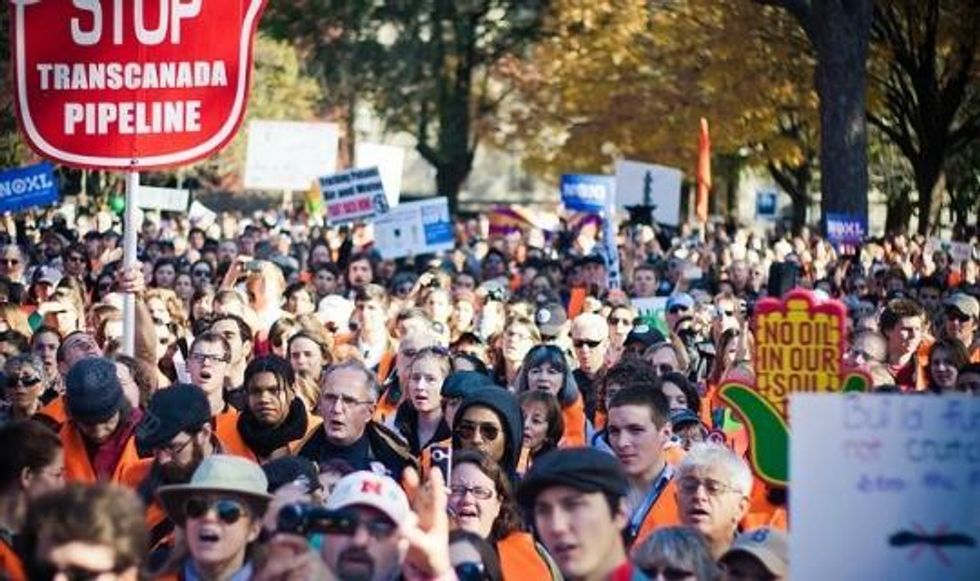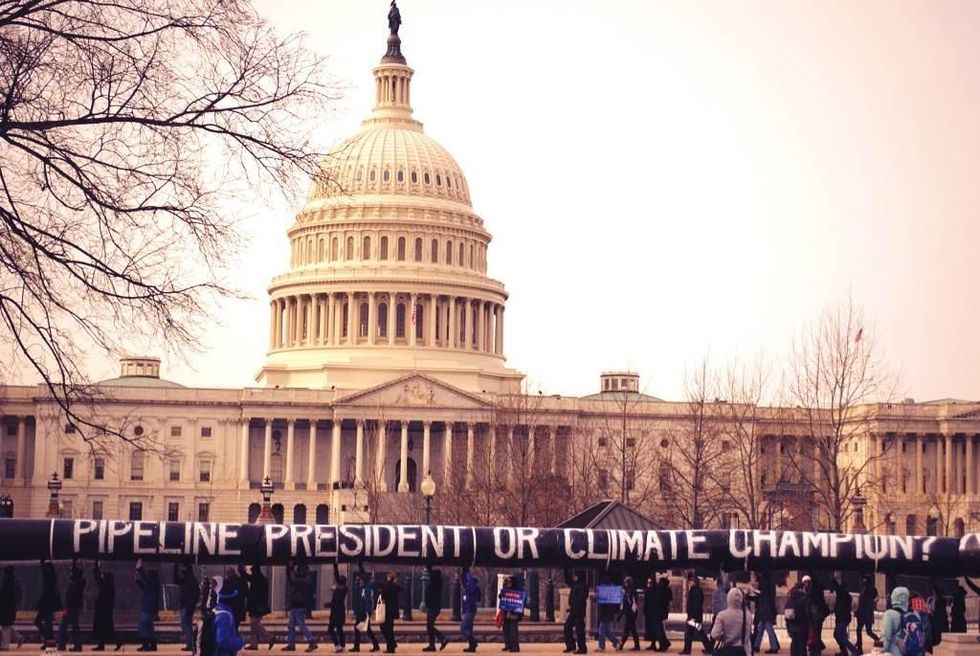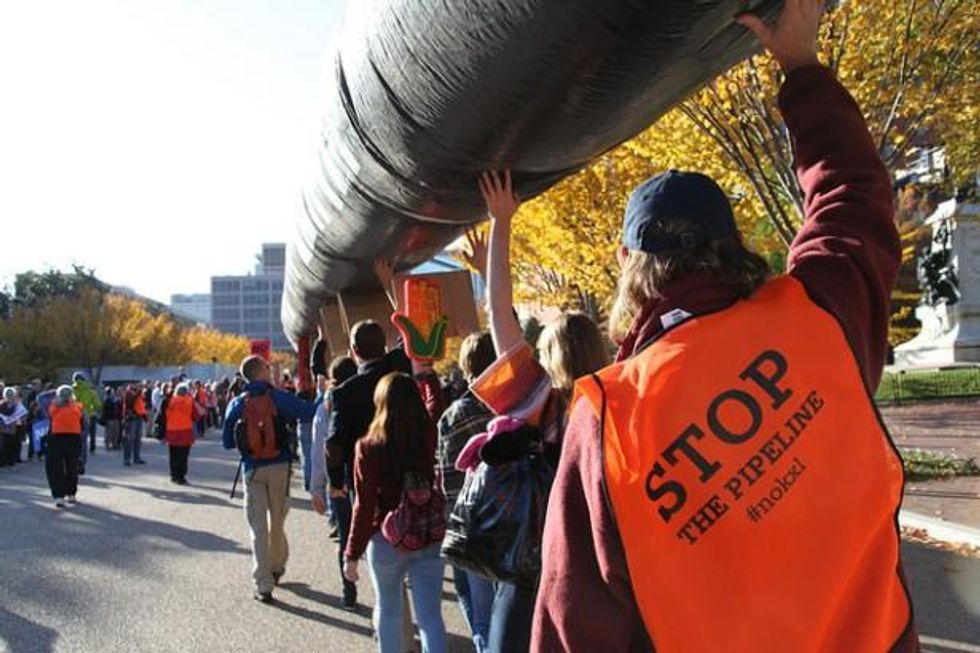

SUBSCRIBE TO OUR FREE NEWSLETTER
Daily news & progressive opinion—funded by the people, not the corporations—delivered straight to your inbox.
5
#000000
#FFFFFF
To donate by check, phone, or other method, see our More Ways to Give page.


Daily news & progressive opinion—funded by the people, not the corporations—delivered straight to your inbox.

"Right now we are in the middle of the last official public comment period for Keystone XL -- one of the very last steps before President Obama makes his decision on the pipeline, and the final opportunity to give your input (in an official way)," writes 350.org on their website, which offers a one-step form to file a comment with the State Department.
"The State Department is accepting comments on the Final Environmental Impact Statement, and the last time State was accepting comments, we submitted over 1 million as a movement--let's see if we can beat that goal this time around," the group writes.
The 30-day public comment period ends on March 7th, at which point Obama will be open to make his final decision.
And on Thursday night, campaigners plan to submit those comments in a less formal way: projecting them on the outside walls of the State Department building.
Groups The Other 98%, 350.org, and the Light Brigade will use what they call "The Illuminator," a large-scale projector, to project comments asking the administration to say no to the pipeline and other anti-Keystone XL messages on the State Department building.
"We are fed up with the State Department's conflict-ridden, Big Carbon influenced, Keystone XL consideration process," said Nicole Carty, actions coordinator for The Other 98%. "That's why, with the help of 'The Illuminator,' we're going to light up the State Department with the comments they'd prefer to ignore."
A report released this week by The Carbon Tracker Initiative showed that the development of the Keystone XL pipeline would have far greater ramifications for the climate than was highlighted in the State Department's recently released final environmental impact analysis. President Obama has said he would approve the pipeline "only if this project doesn't significantly exacerbate the problem of carbon pollution."
On Sunday, hundreds of students were arrested in the largest single day of civil disobedience throughout the Keystone XL "saga," protest organizers said. Over 1,200 students conducted a mass sit-in in front of the White House, demanding the Obama administration reject the pipeline.
______________________
The Keystone XL tar sands pipeline into the highest profile environmental fight in recent memory

Earlier this morning, I took a break from press calls and preparations for this weekend's big XL Dissent protest in Washington, D.C. to go back and watch some of the original videos we made during Tar Sands Action, the two-weeks of sit-ins in August 2011 that helped turn the Keystone XL tar sands pipeline into the highest profile environmental fight in recent memory.
In a video from the first day of the protests, Gus Speth, a former White House official and co-founder of the Natural Resources Defense Council, says, "We have to draw a line in the sand somewhere and this is a perfect place to draw it. It's a new, controversial, unconventional fossil resource with tremendous potential to harm the global climate, and for Obama to do something in his own power which doesn't require Congress, that would be electrifying and send a powerful signal around this country and around the world that we are going to act."
Tar Sands Action: Come Join Us!A short film capturing first day of 2-weeks of sit-ins at the White House to stop the proposed Keystone XL Pipeline. More info: ...
He continues, "Power responds to a demand and we have to let that demand be heard. It's time to step outside the system and do some things we haven't done before."
Speth was arrested that day and spent two nights in DC central cell block. He got a message out from jail that read, "The only thing we need is more company."
"From the fossil fuel divestment movement to the increasing levels of direct action and civil disobedience, young people are finding powerful ways to make an impact and stand in solidarity with the frontline communities who are feeling the impacts of our dirty energy economy and the climate crisis."
And boy, did he get it. Over the two weeks of Tar Sands Action, 1,253 people were arrested during daily sit-ins protesting the pipeline. Since then, arrests have continued across the country, from the Tar Sands Blockade in Texas, to young people in Michigan (who are still fighting charges), to more civil rights and environmental leaders back at the White House. Those that have gone to jail have been joined by tens of thousands more protesters in the streets during events like Forward on Climate, which brought over 40,000 people to the Capitol last February.
This weekend, will be the largest single act of civil disobedience yet. Over 1,000 students and young people are expected to take part in the XL Dissent protest at the White House. More than 300 of them are planning on risking arrest. If the action goes according to plan, it could turn out to be the largest youth-led act of civil disobedience at the White House in a generation.
I've had the chance to talk with some of the students involved in XL Dissent and the thing that continues to strike me is how level-headed and pragmatic they are. They're risking arrest this weekend not because they're wild-eyed radicals, but because they agree with Speth that power responds to a demand, and that getting that demand heard often requires working outside traditional channels.
Howard Zinn wrote, "Protest beyond the law is not a departure from democracy; it is absolutely essential to it." After years of greening campuses, pushing for recycling and carbon neutrality, and educating their classmates about the threat of climate change, students are increasingly adopting protest as a tool for social change. From the fossil fuel divestment movement to the increasing levels of direct action and civil disobedience, young people are finding powerful ways to make an impact and stand in solidarity with the frontline communities who are feeling the impacts of our dirty energy economy and the climate crisis.
President Obama should know something about the power of principled protest. As he recounts in his autobiography "Dreams From My Father," his first public speech was at a college rally pushing for divestment from apartheid South Africa. As the President looks out from the windows of the White House this Sunday at the hundreds of student activists getting taken away from his fence in handcuffs, many of them divestment organizers back on campus, perhaps it will remind him of the reasons that got him into politics in the first place.
Keystone XL is more than an environmental issue, it's a test of character. The young people taking part in XL Dissent are demonstrating theirs. Now, it's time for the President to show his.
Architecturally, a keystone is the wedge-shaped piece at the crown of an arch that locks the other pieces in place. Without the keystone, the building blocks of an archway will tumble and fall, with no support system for the weight of the arch.

This is a dangerous place to be. Once Barack Obama makes his decision on the pipeline, be it approval or rejection, the keystone will disappear. Without this piece, we could see the weight of the arch tumble down, potentially losing throngs of newly inspired climate activists. As members of Rising Tide North America, a continental network of grassroots groups taking direct action and finding community-based solutions to the root causes of the climate crisis, we believe that to build the climate justice movement we need, we can have no keystone -- no singular solution, campaign, project, or decision maker.
The Keystone XL fight was constructed around picking one proposed project to focus on with a clear elected decider, who had campaigned on addressing climate change. The strategy of DC-focused green groups has been to pressure President Obama to say "no" to Keystone by raising as many controversies as possible about the pipeline and by bringing increased scrutiny to Keystone XL through arrestable demonstrations. Similarly, in Canada, the fight over Enbridge's Northern Gateway tar sands pipeline has unfolded in much the same way, with green groups appealing to politicians to reject Northern Gateway.
However, the mainstream Keystone XL and Northern Gateway campaigns operate on a flawed assumption that the climate movement can compel our elected leaders to respond to the climate crisis with nothing more than an effective communications strategy. Mainstream political parties in both the US and Canada are tied to and dependent on the fossil fuel industry and corporate capitalism. As seen in similar campaigns in 2009 to pass a climate bill in the United States and to ratify an international climate treaty in Copenhagen, the system is rigged against us. Putting Obama and Canadian Prime Minister Stephen Harper at the keystone of the archway creates a flawed narrative that if we, as grassroots groups, work hard enough to stack the building blocks correctly to support them, then elected officials will do what we want. Social change happens when local communities lead, and only then will politicians follow. While we must name and acknowledge power holders like Obama, our movement must empower local communities to make decisions and take action on the causes of the climate crisis in their backyards.
Because of the assumption that the climate movement can trust even "sympathetic" politicians like Obama, these campaigns rely on lifting up one project above all else. Certain language used has made it seem like Keystone XL is an extreme project, with unusual fraud and other injustices associated with it. Indeed the Keystone XL project is extreme and unjust, as is everyfossil fuel project and every piece of the extraction economy. While, for example, the conflict of interests between the State Department, TransCanada and Environmental Resources Management in the United States, and Enbridge and federal politicians in Canada, must be publicized, it should be clear that this government/industry relationship is the norm, not the exception.
The "game over for climate" narrative is also problematic. With both the Keystone and Northern Gateway campaigns, it automatically sets up a hierarchy of projects and extractive types that will inevitably pit communities against each other. Our movement can never question if Keystone XL is worse than Flanagan South (an Enbridge pipeline running from Illinois to Oklahoma), or whether tar sands, fracking or mountaintop removal coal mining is worse. We must reject all these forms of extreme energy for their effects on the climate and the injustices they bring to the people at every stage of the extraction process. Our work must be broad so as to connect fights across the continent into a movement that truly addresses the root causes of social, economic, and climate injustice. We must call for what we really need -- the end to all new fossil fuel infrastructure and extraction. The pipeline placed yesterday in British Columbia, the most recent drag lines added in Wyoming, and the fracking wells built in Pennsylvania need to be the last ones ever built. And we should say that.
This narrative has additionally set up a make-or-break attitude about these pipeline fights that risks that the movement will contract and lose people regardless of the decision on them. The Keystone XL and Northern Gateway fights have engaged hundreds of thousands of people, with many embracing direct action and civil disobedience tactics for the first time. This escalation and level of engagement is inspiring. But the absolutist "game over" language chances to lose many of them. If Obama approves the Keystone XL pipeline, what's to stop many from thinking that this is in fact "game over" for the climate? And if Obama rejects Keystone XL, what's to stop many from thinking that the climate crisis is therefore solved? We need those using the "game over" rhetoric to lay out the climate crisis' root causes -- because just as one project is not the end of humanity, stopping one project will not stop runaway climate change.
The fights over Keystone XL and Northern Gateway have been undoubtedly inspiring. We are seeing the beginnings of the escalation necessary to end extreme energy extraction, stave off the worst effects of the climate crisis, and make a just transition to equitable societies. Grassroots groups engaging in and training for direct action such as the Tar Sands Blockade, Great Plains Tar Sands Resistance, the Unist'ot'en Camp, and Moccasins on the Ground have shown us how direct action can empower local communities and push establishment green groups to embrace bolder tactics. Our movement is indeed growing, and people are willing to put their bodies on the line; an April poll by the Yale Project on Climate Change Communication found one in eight Americans would engage in civil disobedience around global warming.
However, before the Keystone XL and Northern Gateway mainstream campaigns come to an end, we all must recognize the dangers of having an archway approach to movement building. It is the danger of relying on political power-holders, cutting too narrow campaigns, excluding a systemic analysis of root causes, and, ultimately, failing to create a broad-based movement. We must begin to discuss and develop our steps on how we should shift our strategy, realign priorities, escalate direct action, support local groups and campaigns, and keep as many new activists involved as possible.
We are up against the world's largest corporations, who are attempting to extract, transport and burn fossil fuels at an unprecedented rate, all as the climate crisis spins out of control. The climate justice movement should have no keystone because we must match them everywhere they are -- and they are everywhere. To match them, we need a movement of communities all across the continent and the world taking direct action to stop the extraction industry, finding community-based solutions, and addressing the root causes of the climate crisis.
This article appears through a collaboration with Earth Island Journal and was jointly published there.